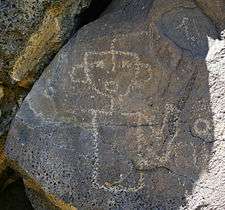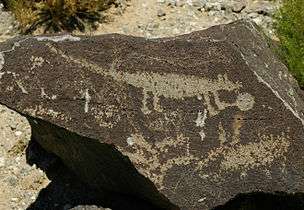Petroglyph National Monument
| Petroglyph National Monument | |
|---|---|
|
IUCN category V (protected landscape/seascape) | |
  | |
| Location | Bernalillo County, New Mexico, US |
| Nearest city | Albuquerque, NM |
| Coordinates | 35°8′9″N 106°45′43″W / 35.13583°N 106.76194°WCoordinates: 35°8′9″N 106°45′43″W / 35.13583°N 106.76194°W |
| Area | 7,532 acres (3,048 ha)[1] |
| Authorized | June 27, 1990 |
| Visitors | 114,428 (in 2011)[2] |
| Governing body | National Park Service |
| Website | Petroglyph National Monument |


Petroglyph National Monument stretches 17 miles (27 km) along Albuquerque, New Mexico's West Mesa, a volcanic basalt escarpment that dominates the city's western horizon. Authorized June 27, 1990, the 7,236 acre (29.28 km2) monument is cooperatively managed by the National Park Service and the City of Albuquerque. The western boundary of the monument features a chain of dormant fissure volcanoes. Beginning in the northwest corner, Butte volcano is followed to its south by Bond, Vulcan, Black and JA volcanoes.
Petroglyph National Monument protects a variety of cultural and natural resources including five volcanic cones, hundreds of archeological sites and an estimated 24,000 images carved by Ancestral Pueblo peoples and early Spanish settlers. Many of the images are recognizable as animals, people, brands and crosses; others are more complex. Their meaning was, possibly, understood only by the carver. These images are the cultural heritage of a people who have long since moved into other areas and moved on through history for many reasons. The monument is intended as a protection for these lands and sites from and for visitors to see and appreciate for generations to come. The National Monument is managed in a manner that allows recreational use.
Stupa controversy
In 1989, at least a year prior to the National Monument's establishment, a Tibetan Buddhist stupa was built and consecrated on what was then private land owned by Harold Cohen and Ariane Emery. The National Park Service subsequently used eminent domain to seize this land and make it part of the Monument, over the owners' objections. The stupa was not removed, but all buildings on the land were razed.
On June 10, 2010, the Superintendent of Petroglyph National Monument sent an email stating that "[w]hile soils are being stockpiled nearby for the future construction of an amphitheater, the National Park Service has no plans for the Stupa."[3] The Monument website was also updated to describe the construction projects and clarify that the Stupa was not to be demolished.
Other controversies
Suburban development is now another enemy of the Petroglyph National Monument site. The city of Albuquerque succeeded with their plans to build a 4 lane highway directly through the site itself. The boulders with inscribed petroglyphs were relocated, so, the developers claim, were destroyed.[4][5] The issue was featured in the documentary, Reclaiming Their Voice: The Native American Vote in New Mexico & Beyond.
The Petroglyph National Monument is a major asset for the City of Albuquerque and New Mexico but its rich trove of cultural and natural resources is threatened by the inability of the City and the National Park Service (NPS) to cooperatively manage the two-thirds of the monument that is City-owned land, according to documents posted on June 6, 2012 by Public Employees for Environmental Responsibility (PEER). As a result, there are no consistent management standards or patrols protecting the invaluable rock art for which the Monument was created.
Under a five-year Cooperative Management Agreement, National Park Service and the City specify the delegation of their respective responsibilities for the monument. The City, however, refuses to allow NPS rangers to patrol or enforce Park Service rules on City lands, which constitute the bulk of the monument. Due to City service cutbacks, most of the Petroglyph is left unpatrolled. In a July 25, 2011 letter to PEER, NPS Intermountain Regional Director John Wessels stated –
 | |
|
|
"However, the NPS currently has no agreement with the City of Albuquerque that holistically authorizes NPS to enforce the entirety of 36 CFR Part 2 on lands owned by the city ... We would welcome such an agreement and we have, in the past, proposed such an agreement with the City, but the City has not acceded to this proposal."
"It is a disgrace that ancient rock art is obscured by both years of debris and last weekend's vandalism," Daniel Patterson Southwest Public Employees for Environmental Responsibility Director added.[7] "Petroglyph is not just a regional but a national treasure which deserves the same protections as other national parks.”
The 2008 Cooperative Management Agreement must be renewed by May 2013. Public Employees for Environmental Responsibility has launched a citizen petition and national campaign to persuade Albuquerque Mayor Richard J. Berry to allow NPS to provide full monument protection in the upcoming cooperative management pact.
Photo Gallery
 Petroglyph at Petroglyph National Monument, NM
Petroglyph at Petroglyph National Monument, NM Petroglyph at Petroglyph National Monument, NM
Petroglyph at Petroglyph National Monument, NM Petroglyph at Petroglyph National Monument, NM
Petroglyph at Petroglyph National Monument, NM Petroglyph at Petroglyph National Monument, NM
Petroglyph at Petroglyph National Monument, NM Petroglyph at Petroglyph National Monument, NM
Petroglyph at Petroglyph National Monument, NM Petroglyph at Petroglyph National Monument, NM
Petroglyph at Petroglyph National Monument, NM Petroglyph at Petroglyph National Monument, NM
Petroglyph at Petroglyph National Monument, NM Petroglyph at Petroglyph National Monument, NM
Petroglyph at Petroglyph National Monument, NM Petroglyph at Petroglyph National Monument, NM
Petroglyph at Petroglyph National Monument, NM Petroglyph at Petroglyph National Monument, NM
Petroglyph at Petroglyph National Monument, NM Petroglyph at Petroglyph National Monument, NM
Petroglyph at Petroglyph National Monument, NM Petroglyphs at Petroglyph National Monument, NM
Petroglyphs at Petroglyph National Monument, NM Petroglyph at Petroglyph National Monument, NM
Petroglyph at Petroglyph National Monument, NM Petroglyphs at Petroglyph National Monument, NM
Petroglyphs at Petroglyph National Monument, NM Petroglyph at Petroglyph National Monument, NM
Petroglyph at Petroglyph National Monument, NM Petroglyph at Petroglyph National Monument, NM
Petroglyph at Petroglyph National Monument, NM Petroglyphs at Petroglyph National Monument, NM
Petroglyphs at Petroglyph National Monument, NM Petroglyph at Petroglyph National Monument, NM
Petroglyph at Petroglyph National Monument, NM
See also
References
- ↑ "Listing of acreage as of December 31, 2011". Land Resource Division, National Park Service. Retrieved 2012-05-14.
- ↑ "NPS Annual Recreation Visits Report". National Park Service. Retrieved 2012-05-14.
- ↑ News from stupa owner
- ↑ Paseo del Norte Extension, Albuquerque - New Mexico | Wilson & Company
- ↑ "Sacred Land Film Project » Petroglyph National Monument". Retrieved 20 August 2016.
- ↑ "Petroglyph National Monument". C-SPAN. February 4, 2013. Retrieved March 15, 2013.
- ↑ Public Employees for Environmental Responsibility Petroglyph National Monument Press Release
External links
| Wikimedia Commons has media related to Petroglyph National Monument. |
- National Park Service: Petroglyph National Monument
- A Report on the Petroglyph National Monument
- Petroglyph Segment in the documentary, on YouTube Reclaiming Their Voice: The Native American Vote in New Mexico & Beyond